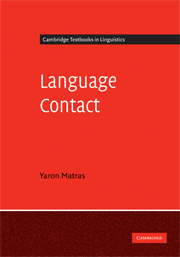Book contents
- Frontmatter
- Contents
- List of figures
- Preface
- List of abbreviations
- 1 Introduction
- 2 An emerging multilingual repertoire
- 3 Societal multilingualism
- 4 Acquiring and maintaining a bilingual repertoire
- 5 Crossing the boundaries: codeswitching in conversation
- 6 The replication of linguistic ‘matter’
- 7 Lexical borrowing
- 8 Grammatical and phonological borrowing
- 9 Converging structures: pattern replication
- 10 Contact languages
- 11 Outlook
- Notes
- References
- Author index
- Language index
- Subject index
1 - Introduction
Published online by Cambridge University Press: 05 June 2012
- Frontmatter
- Contents
- List of figures
- Preface
- List of abbreviations
- 1 Introduction
- 2 An emerging multilingual repertoire
- 3 Societal multilingualism
- 4 Acquiring and maintaining a bilingual repertoire
- 5 Crossing the boundaries: codeswitching in conversation
- 6 The replication of linguistic ‘matter’
- 7 Lexical borrowing
- 8 Grammatical and phonological borrowing
- 9 Converging structures: pattern replication
- 10 Contact languages
- 11 Outlook
- Notes
- References
- Author index
- Language index
- Subject index
Summary
The study of language contact
Manifestations of language contact are found in a great variety of domains, including language acquisition, language processing and production, conversation and discourse, social functions of language and language policy, typology and language change, and more. This makes it a special challenge to compile an overview of the subject. Most introductory works devoted to contact linguistics have hitherto chosen to specialise either in the individual-synchronic aspects of bilingualism, or in structural-diachronic aspects of contact-induced language change. This book introduces an integrated theory of language contact, within which the study of these various domains can be bound together.
Since the launch of modern contract linguistics through the works of Weinreich (1953) and Haugen (1953), the study of individual bilingualism and of societal multilingualism has occupied a centre-stage position in the field. A testimony to this position is provided by a series of introductory textbooks that focus on one or both these areas, covering topics such as the acquisition of two languages from birth, bilingual language processing, diglossia and societal bilingualism, and language policy in multilingual communities (see Grosjean 1982, Hamers and Blanc 1989, Romaine 1989, Hoffmann 1991). Appel and Muysken's (1987) textbook was one of the first introductory works to take into account diachronic aspects of contact-induced language change. It was soon followed by Thomason and Kaufman's (1988) monograph, which remains one of the most influential and frequently cited works on language contact in the context of historical linguistics.
- Type
- Chapter
- Information
- Language Contact , pp. 1 - 8Publisher: Cambridge University PressPrint publication year: 2009

